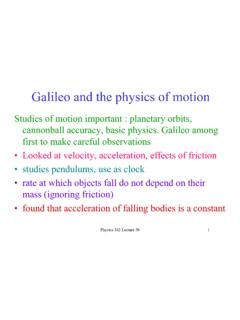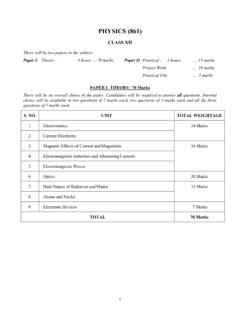Transcription of 3 Class A-surface
1 Copyright by Richard Haslauer3 Class ger man term Strak (in Eng lish: Class A-sur face) has its or i gins in the shipbuild ing where com pli cated free form sur faces were de scribed with ver ti cal, lon gi tu -di nal and cross sec tions (frames). In the au to mo tive sec tor this method was adaptedfor the gen er a tion of all non-pla nar free form sur faces in the ex te rior and in te riorwork. Be fore CA-tools came into play de sign sur faces were based on so-called sec -tions which re flect the main curves (char ac ter lines).For the last 20 years we have been gen er at ing sur faces with the help of CA-tools.
2 Inthis con text, the soft ware ICEM-Surf es tab lished it self to be the stan dard tool forsur fac ing, where dif fer ent anal y sis meth ods like high lights, iso met ric lines as well ascur va ture guar an tee the surface quality in real time. GClass A-sur faces are the con ver sion of styl ing data into tech ni cally re al iz ablesur faces . In this chap ter we ex clu sively talk about sub jects con cern ing the outer skin (ex te riorwork), but the de scribed pro cesses as well as the meth ods can be ap plied to the in te -rior work or other de sign top ics as Fig ure "Sections" on a bonnet outer shapeCopyright by Richard design process of Class A-surfacesThe first step in a de vel op ment pro cess con sists in find ing the de sign of the newprod uct.
3 Start ing from ini tial out lines a phys i cal model is formed. In or der to pro cessthis model in CAD we need CAS data or a metrological cap ture of the shape. The Class A-sur face de sign ers have to con vert the digit ised points or the CAS data intomanufacturable sur faces in or der to de liver data for the fol low ing de sign steps, thestrength cal cu la tion and the man u fac tur ing. The de vel op ment of a ve hi cle is di videdinto dif fer ent pe ri ods. The il lus tra tion be low shows an over view of the different con cept level dif fer ent con cepts are to be ex am ined con cern ing their fea si bil ity.
4 In ad di tion to this, first eco nomic eval u a tions and pro duc tion sched ules are done. Atthis point the Class A-sur faces are not of very high qual ity, we rather need quicklyde signed sur faces in or der to de scribe the dif fer ent con cept mod els. Once this level ister mi nated, we ob tain one fa vour able con cept. The sur faces nec es sary for the test ve -hi cles are de signed based on their scan this case, the qual ity of the Class A-sur face con cern ing man u fac tur ing and mounting has to be in creased. In the con fir ma tion pe riod the ex pe ri ences re sult ingfrom the tests are pro cessed.
5 More over, man u fac tur ing lines and tools for the se rialpro duc tion are planned. At that level, the de scrip tion of Class A-sur faces gets moreand more de tailed, the de sign of the joints starts. Based on the de signed sur faces ahard ware model is milled, well known as cub ing model. At the end of the car body de vel op ment pro cess se rial Class A-sur faces are gen er ated. The qual ity of these data has to be on high est level, and at this point we talk of ClassA- surfaces . Finally, a serial cubing model is Class A-surfaceStyling processClass A-surfacingconcept surface, Class A-surfacemodelscubing modelcubing modeltest vehicleSeries Class A-surfacetest vehiclestyling freezestylingscanningproportion modelsCAS-modelsFig ure Sche matic di a gram of the de sign pro cess in " Class A-sur fac ing"Copyright by Richard styling data related component design processWhen we talk of CATIA V4, the styl ing data re lated com po nent de sign pro cess is anearly se rial one.
6 In given cy cles the sur fac ers are pro vided with styl ing data. Herethe sur faces are de signed and passed on to the com po nent de sign ers. In any case, Idon t want you to get the im pres sion that these jobs were not done si mul ta neously. But in a non-as so cia tive pro cess like in CATIA V4, the sur faces sub ject to changeshave to be re de signed in the fol low ing pro cess. In an as so cia tive pro cess CATIA V5can as sume many op er a tions of the work flow in case of mod i fi ca tions or en ables thecom po nent de signer to work on as sump tions at a cer tain time. Fur ther more, he canwork with sub sti tute ge om e try if a cer tain maturity of data does not yet of the design processIn an as so cia tive pro cess we re or gan ise the workflow, be cause only by this we areable to re duce the time nec es sary for de vel op ment.
7 This has an im pact on the fol low -ing topics:lThe contents of Class A-surfaceslClass A-surface conventionslThe styling data related component design processCo-operation between 2 assembliesCo-operation within an assemblylUsage of the adapter model as a design bufferlDividing the components into directly Class A-surface depending componentsindirectly Class A-surface depending componentslAdapting the design method applied at component level tosheet-metal componentsvolume based components31 IntroductionFig ure De sign pro cess " Class A-sur fac ing" and com po nent designCopyright by Richard Class A-surface related component design
8 ProcessDue to an as so cia tive de sign pro cess we are able to re struc ture the de vel op ment pro -cess be tween Class A-sur face and com po nent de sign. In the fol low ing chap ters thein no va tions will be de il lus tra tion above shows the data flow be tween the 3 de sign pro cesses. The redar rows rep re sent the in put, the pro cess gets data from his pro cess part ner in or derto eval u ate and to work on them. The blue ar rows show the pass ing on of data to thedesign steps to Class A-surfaceneighbouring geometryconcept geometry modelsdetailing modelsworking modeldesign sectionClass A-surfaceassembly 2adapter modelcomponent 2component 1component xcomponent designconcept workClass A-surface designClass A-surfaceassembly 1passing oninputinputinputinputFig ure Co-operation be tween con cept work.
9 Sur fac ing and com po nent designCopyright by Richard design process between 2 component assembliesThe fol low ing il lus tra tion shows the tem po ral de vel op ment pro cess be tween 2 com -po nent as sem blies. For our new align ment let s have a look at the pro cess be tween avir tual as sem bly and the first hard ware as sem 4 bars de scribe the workflow of the in volved de sign steps ( Class A-sur faces , con -cept work, com po nent de sign, outer skin and com po nent de sign and in di rectly de -pend ent com po nents). The up per bar rep re sents the time sched ule (syn chro points)de scrib ing in dif fer ent colours the start and the end of a pe riod.
10 The yel low tri an glere fers to the Class A-sur faces , the blue one on the con cept work and green one on thecom po nent de sin gle steps which are marked with , will be explained on the or der to put this pro cess into prac tice, we have to de fine new pre The com po nent de signer de ter mines the flanges, hem ra dii, etc. and the surfacer in -te grates these re quire ments into his Class A-sur faces !2. The com po nents de pend ing on the outer skin (CATP arts) are al ways pro vided withthe same in put in the form of sur faces . This means: Miss ing spec i fi ca tions have tobe worked in!



